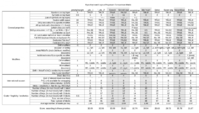Grench
Forum Addict!
- Joined
- Oct 3, 2008
- Messages
- 6,629
I'd really like ED's opinion first about what the layouts MUST have and what they MUST NOT have. There's little point in voting about doomed layouts. We could try to extract features from the current proposals and make a poll about them with "must have" "may have" "must not have" scale. These features should contain all the essential design choices (for example in mine that would be full button compatibility with US International keyboard and a mostly unmapped modifier for custom stuff) in all of the layouts, and most of the secondary ones. If we could get community and developer opinion on those we could prune or modify layouts that will never be viable.
Much as we would like to believe, ED is not omniscient. He won't know what the layouts MUST have any more than the rest of us did prior to doing the hard work of researching and learning what works and what does not.
What the keyboard 'must have' is different from what it 'should have'. Example: Letters of the English alphabet.
The items that it 'should have' wind up being user opinion dependent and in direct conflict with each other. Examples of 'should have':
- DosBox/QEMU compatibility
- English letter keys on top layer (unFn A-Z)
- Numbers on top layer (unFn 1-0)
- Symbols on top layer (UnFn `-=[]\;',./)
- AltGr compatibility (REAL AltGr as in right-Alt)
- P+3 and L+2
- Modifier controls (Shift, Fn, Alt, Ctrl) on the keyboard to match the controls on the shoulder buttons
- Only 3 symbols per key
- "Uncluttered"
- International friendly
If the WERE all equally weighted, this layout's 'score': http://www.keyboard-layout-editor.com/#/layouts/5396ee5f893d78a100dcce1859febcd0
+1 DosBox/QEMU compatibility
+1 English letter keys on top layer (unFn A-Z)
-1 Numbers on top layer (unFn 1-0)
+1 Symbols on top layer (UnFn `-=[]\;',./)
+1 AltGr compatibility (REAL AltGr as in right-Alt)
+0 P+3 and L+2 (They are present as the surfaced symbol keys, but they aren't in the right place)
+1 Modifier controls (Shift, Fn, Alt, Ctrl) on the keyboard to match the controls on the shoulder buttons
+1 Only 3 symbols per key
+1 "Uncluttered"
+1 International friendly
Score: +8 -1 = 7.
This one was a _wb_ modification & cleanup of one of my layouts: http://www.keyboard-layout-editor.com/#/layouts/3cc8046592f2ce4e6d11ab695b7a1035
+1 DosBox/QEMU compatibility
+1 English letter keys on top layer (unFn A-Z)
+1 Numbers on top layer (unFn 1-0)
-1 Symbols on top layer (UnFn `-=[]\;',./)
+1 AltGr compatibility (REAL AltGr as in right-Alt)
-1 P+3 and L+2
+1 Modifier controls (Shift, Fn, Alt, Ctrl) on the keyboard to match the controls on the shoulder buttons
-1 Only 3 symbols per key
+1 "Uncluttered"
+1 International friendly
Score: +7 -3 = 4.
Another one of mine (my primary one) with the 'kitchen sink' approach:
http://www.keyboard-layout-editor.com/#/layouts/fcd69e93d9f1fdd811c8d13cc212f3a6
+1 DosBox/QEMU compatibility
+1 English letter keys on top layer (unFn A-Z)
+1 Numbers on top layer (unFn 1-0)
-1 Symbols on top layer (UnFn `-=[]\;',./)
+1 AltGr compatibility (REAL AltGr as in right-Alt)
-1 P+3 and L+2
+1 Modifier controls (Shift, Fn, Alt, Ctrl) on the keyboard to match the controls on the shoulder buttons
-1 Only 3 symbols per key
-1 "Uncluttered"
+1 International friendly
Score: +6 -4 = 2.
Does this seem like a fair way to grade layouts? Are there other factors that should be added into the 'Should Have' list?
Should we 'grade' more layouts?
Last edited by a moderator:


